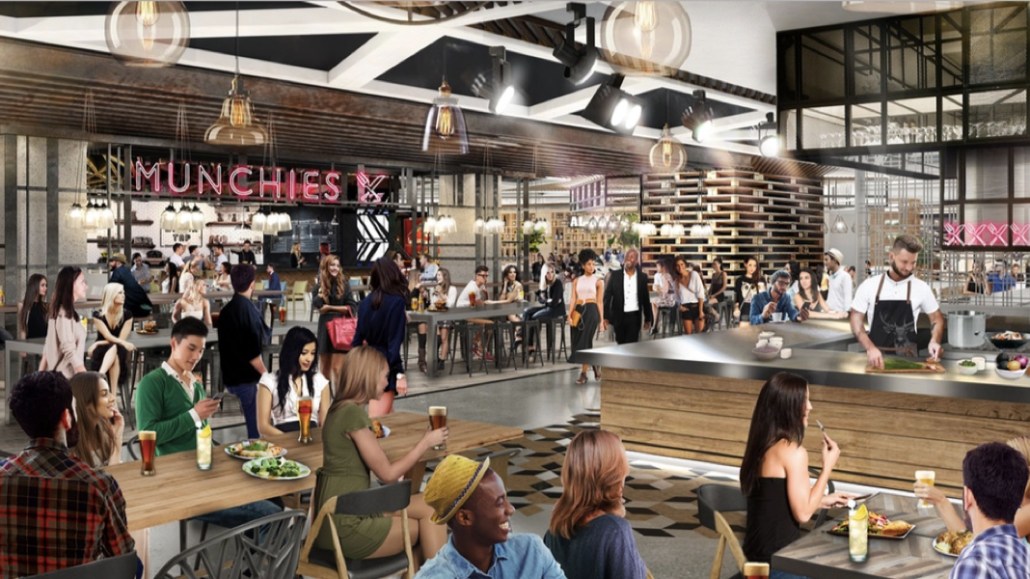
Munchies is shopping for chefs and restaurants to bake into its newest endeavor: a food court.
The Vice and Fremantle Media co-owned publisher recently signed a brand licensing deal with developer Triple Five Group, putting it in charge of a food hall at American Dream, a 3 million square-foot shopping and entertainment complex set to open in the Meadowlands, New Jersey, in the spring of 2019. Munchies’ food court, one of American Dream’s two food halls, will feature space for 18 vendors, as well as a staging area where a team can shoot videos and chefs can do demos.
Thanks to its proximity to MetLife Stadium, as well as American Dream’s own dizzying list of attractions — a 12-story indoor ski hill, the world’s largest indoor water park, a Ferris wheel, a luxury retail shopping center and a “4-D” movie theater — Munchies expects the complex to host 40 million visitors per year.
As a part of the agreement, Munchies gets a brand licensing fee, plus royalties that change depending on how much revenue the food court generates. It declined to share specific financial details of the deal.
Munchies will select the vendors that will both represent the publisher’s sensibility and deliver something that feels appropriate to the food hall’s setting. A cocktail party for possible targets is in the works, along with outreach to chefs the publisher has worked with in the past.
“I don’t want this to be really self-indulgent,” said Munchies co-founder and publisher John Martin. “If you’re going to do a food court, there are certain things you need. You should have sandwiches. You should have pizza.”
Like many other food-focused publishers, Munchies has cast a wide net for non-ad revenue. It partnered with Chef’d on a series of meal kits (Chef’d folded unexpectedly in July); last spring, Munchies published its first cookbook, “Chef’s Night Out,” and has two more coming in the next 12 months; it also regularly hosts branded events at its Williamsburg headquarters.
Those other streams of revenue account for a “meaningful” yet minority share of Munchies’ revenue, Martin said. It also makes money by producing shows for Viceland, creating branded content for advertisers and from selling ads on its site. Since the site launched four years ago, digital ad revenue has gone from 100 percent of revenue to 25 percent, Martin said.
The food court is the latest example of a food publisher extending its brand into the real world. BuzzFeed’s Tasty, for example, recently set up food stalls at Madison Square Garden, and Tastemade, after a number of successful brand-licensing experiments, is eyeing cafes as a new revenue stream to complement its branded-content and video-production business.
Beyond the inherent brand marketing opportunity, Martin sounded optimistic about the food court’s ability to generate different kinds of revenue. Munchies is permitted to sell branded merchandise on site, for example, and it is also free to host events and other kinds of experiential marketing programs there.
That open-ended approach speaks to a recent reversal in the attitudes of mall operators, who historically kept a tight grip on what went on inside their walls.
“Mall operators have historically demanded that brands pay high rates to host events or pop-up activations—in the six-figure range — which really didn’t make sense for marketing activations,” said Karina Masolova, the executive editor of The Licensing Letter, which tracks brand-licensing activity. “But as U.S. malls have begun to feel the crunch, they are beginning to see the value in brands driving foot traffic to their spaces.”
Over time, the programming will be worked out by both the marketing and editorial teams, though Martin expects Munchies will field ideas not only from its own employees but from chefs and sponsors, as well as American Dream.
While that work is in an early stage, Martin said the best-case scenario would involve a kind of content tentpole that would play out at the food court. “The dream would be to do what TRL did in Times Square,” Martin said.
Note: An earlier version of this story said American Dream is 4.5 million square feet. It is 3 million.
More in Media

Here are the biggest moments in AI for publishers in 2025
Here are some of the moments that defined how publishers adapted to the AI era this year.

Digiday+ Research roundup: Gen Z news consumption and diversification in the DSP space were 2025’s top trends
As 2025 winds down, we rounded up the biggest trends of the year, based on the data that resonated the most with Digiday’s readers.

What publishers are wishing for this holiday season: End AI scraping and determine AI-powered audience value
Publishers want a fair, structured, regulated AI environment and they also want to define what the next decade of audience metrics looks like.








